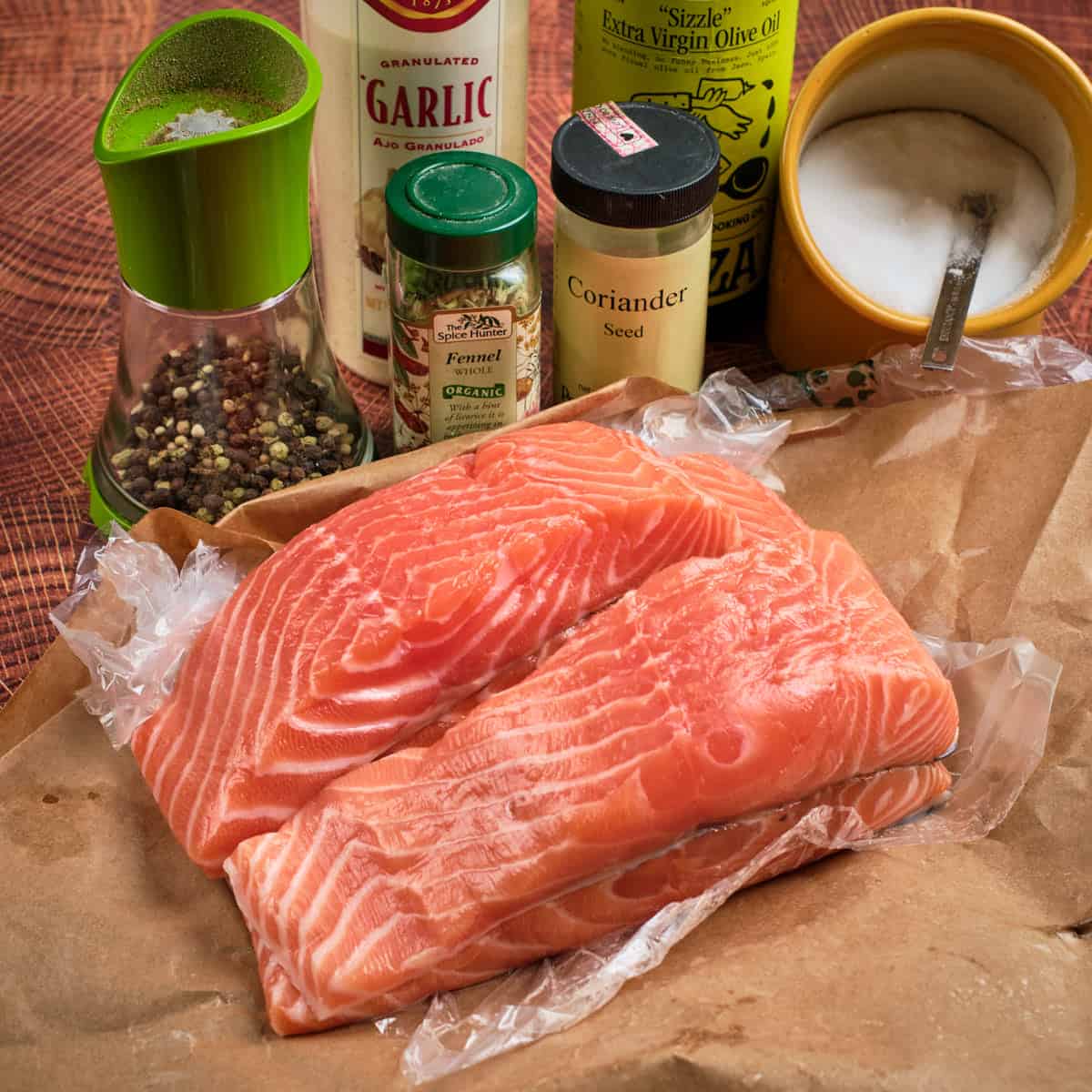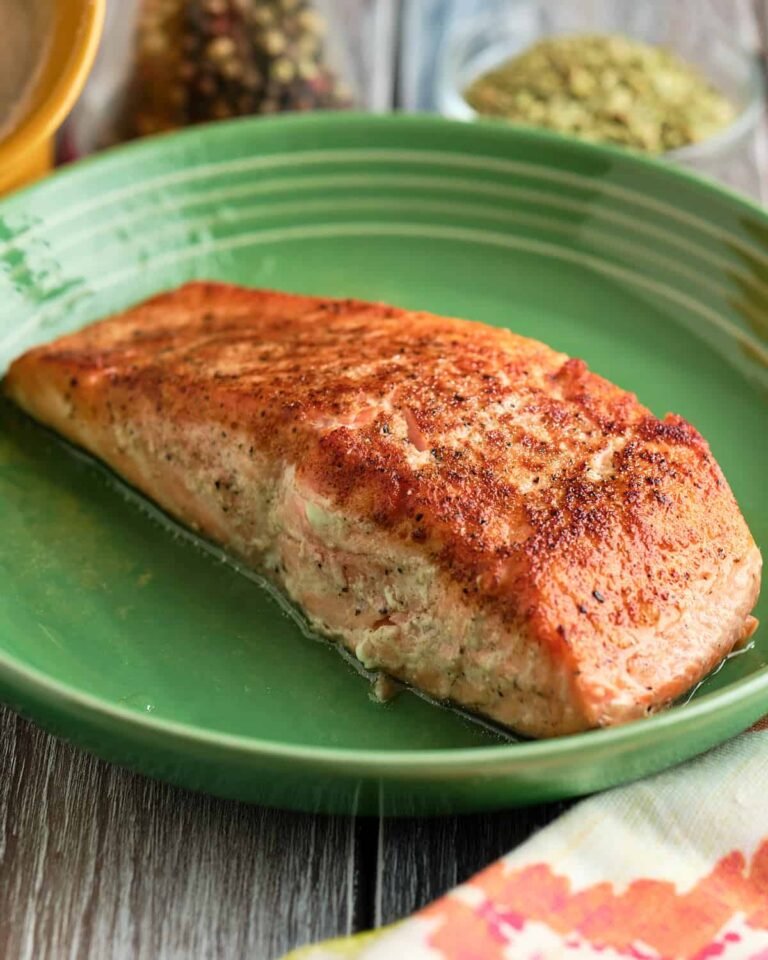Sous Vide Salmon Recipe. Cooking Salmon Sue video offers buttery soft salmon with a melted texture in the mouth that you won’t get with regular cooking methods. I sprinkle spices on the salmon, watch the Sue in the video for 45 minutes, and bake easily on one side for a brown crispy crust. And you can cook from the frozen!

Jump:
Salmon is my favorite fish and Susther’s salmon is my favorite way to cook it. Except for grilled salmon. Or salmon nigiri. Hmm…
Let’s start again: Sous Vide Salmon is definitely one of my top 3 ways to cook salmon. If cooked medium rare, soft and buttery, it is a unique way to serve salmon.
Device
Sous Vide setup (I use ANOVA Sous Vide and Lipavi Sous Vide Tank This post contains Amazon affiliate links Rack) Quart-sized zip-top freezer bag (or vacuum bag and vacuum sealer) Heavy frying pan (optional, if you want to bake salmon, use a 10-inch or 12-inch cast iron frying pan.

material
4 (6 oz) Salmon fillets, 1 inch thick each, 2 teaspoons fine sea salt 1 teaspoon black pepper 1 teaspoon coriander 1 teaspoon 1 teaspoon garlic powder 2 tablespoons olive oil (for bags)
How to Saw Salmon Video


Season the salmon and put it in the bag, then let the salted water dry for 30 minutes.
In a small bowl, mix the sea salt, black pepper, ground coriander and garlic flour until fully combined. Sprinkle about 1 teaspoon of seasoning on each fillet over the salmon. Drizzle the salmon with olive oil, place the salmon in a zip-top bag, and put it in two fillets per bag. If you are using a vacuum bag, seal the bag with the “wet” setting. If you are using a zip top bag, close it in most ways to squeeze all the air and slowly lower it into a Seuss Video water bath, then close the bag completely after the air has been pushed out with water. Place the salmon bag on a plate and refrigerate for 30 minutes to dry the salmon.


Sous video salmon at 122°F for 30 minutes
Set the Seuss Video Bass to 122°F/50°C for medium rare salmon. (Use 131°F/55°C on medium-sized or 115°F/46°C for rare, ultra-lazy salmon) Place the bag in a water bath with a fillet and cook for 30 minutes up to 1.5 hours. (If you have fillets that are more than 1.5 inches thick, cook for 45 minutes to 2 hours.)
Dry the salmon
Remove the bag from the Sous Vide, leave it open, and gently remove the fillet from the bag. (They want to be very soft and fall apart. Dry the fillets with a paper towel.
sear (optional) and serve:
If you want to serve poached salmon, you’re done! If you want a baked crust, preheat a sturdy 12-inch frying pan over medium heat (using a cast iron frying pan and preheat for about 5 minutes). Add vegetable oil, cover the pot in a swirl, and place the fillet in the pot on the skin side. Turn the fillet brown for about 1 minute. (Bake salmon for a few more seconds if it’s still stuck, as the salmon will be released from the pan when the bread is properly browned). Gently activate the spatula under the salmon and carefully move it to the serving plate. Serve and have fun!


Best Sue Video Salmon Tips
Get high quality salmon
Sous Vide is cold cooked and does not kill any foodborne pathogens. Make sure you have high quality fish that is kept at the right temperature. If you really want to pasteurize your salmon, get the thick pieces and watch them in the video at 131°F/55°C for 3.5 hours.
Add salt to the salmon quickly
If you don’t pre-salinate the salmon and rest, some of the salmon’s protein will be pulled onto the surface while cooking, giving the salmon a white chalk look. (This protein is an egg white, the same type of protein in egg whites. When this happens, it tastes better, but doesn’t look like a beautiful pink pink fragment.)
If you salt it quickly, the salt will be absorbed by the fish, and it will melt dry and season deeply. I like to salt the salmon 30 minutes to an hour in advance, but 10 minutes ahead is enough to deal with egg whites.
Do you cook from fresh or frozen? Both work.
You can cook salmon directly from the freezer. It will take a little longer. Add 15 minutes if you are cooking 1 inch thick salmon (or thin) or 30 minutes if the salmon is 1 inch or more thick. The downside of cooking from frozen is that you cannot pre-dried salted water unless you season it with salt before inhaling and seasoning. (If I’m buying pre-frozen, individually vacuum-packed salmon fillets, I can thaw immediately and then dry salted afterwards – see below.)
Can I cook vacuum-packed frozen salmon in a package?
You can, but I don’t recommend it. Individual wrappers are usually not plastic enough to stand up to Sous Vide, especially in a sealed way. (The “Easy Peel” corner is a weakness – I tore them apart in my Sue video bath. Yack). Transfer the salmon to your own vacuum bag or zip top bag, then squeeze out all the air. (See below for tips on removing excess air).
Quick thawing of individually wrapped salmon
If each part of the salmon is shrinking with plastic, you can run a thin stream of cold water and stick it on the bowl. Depending on the thickness of the piece, it takes 15-30 minutes to thaw the salmon. Gently bend the salmon to check and feel if it has been thawed all the time.
How much can I cook salmon sou?
Unlike meat, salmon falls apart when cooked too long. I don’t get much more than 1.5 hours. The best texture is after 45 minutes.
Dry Fish Sears is better
Be sure to gently tap the fish before it cooks. The wet fish steam not brown, until all the liquid on the outside boils. It takes longer to get a good skin for wet salmon to cook the salmon a lot longer.
Do you have a vacuum sealer?
For salmon, that’s fine. Place the salmon pieces in a quart-sized zip-top bag, close the bag and slowly lower it into water, pushing all the air out of the bag. Continue lowering until the zip top is just above the water, then zip and close.
Cooking for people at risk
If you are cooking for someone who needs to make sure the fish is pasteurized, you should cook to medium-splash and extend the cooking time. Cook 1 inch (25mm) thick salmon fillet at 140°F (59°C) for 90 minutes. It’s enough time to pasteurize the salmon and kill bad bacteria. (Also, I cook farmed salmon that I am fed a much more careful diet than wild salmon.) My source is Douglas Baldwin’s incredible website at Sous Vide Cooking.
Indications: A practical guide to Sous Vide Cooking, Douglas Baldwin, Sous Vide Salmon Recipe, J. KenjiLopez-Alt/Serious Eats.
printing
Clock Clock iconcutlery Cutlery Icon Flag Flag Icon Folder Folder Folder ICONINSTAGRAMINSTAGRAMS ICONPINTEREST PINTEREST PINTEREST ICONFACEBOOK Facebook ICONPRINT PRINT ICONSQUARES SQUARES ICONHEART HEART HEART ICONHEARE


Susalmon (scrubbing simple spices)
author: Mike vrobel
Total time: 1 hour 15 minutes
yield: 4 Serving 1x
explanation
Sous Vide Salmon Recipe. Cooking Salmon Sue video offers buttery soft salmon with a melted texture in the mouth that you won’t get with regular cooking methods.
4 (6 oz) Salmon fillet, each 1 Thick inches
2 tsp Thin sea salt
1 tsp Fresh ground black pepper
1 tsp Ground Coriander
1 tsp Ground fennel
1 tsp Garlic powder
2 tsp Olive oil (for bags)
2 tbsp Vegetable oil (optional for burning)
Instructions
Season the salmon and put it in the bag and then let it dry for 30 minutes. In a small bowl, mix the sea salt, black pepper, ground coriander and garlic powder until fully combined. Sprinkle about 1 teaspoon of seasoning on each fillet over the salmon. Drizzle the salmon with olive oil, place the salmon in a zip-top bag, and put it in two fillets per bag. If you are using a vacuum bag, seal the bag with the “wet” setting. If you are using a zip top bag, close it in most ways to squeeze all the air and slowly lower it into a Seuss Video water bath, then close the bag completely after the air has been pushed out with water. Place the salmon bag on a plate and refrigerate for 30 minutes to dry the salmon. Sous surrounds the salmon with video at 122°F for 30 minutes. Set the Sue Video Bass to 122°F/50°C for medium salmon. (Use 131°F/55°C for medium or 115°F/46°C for ultra-lazy rare salmon) Place the bag in a water bath and cook for up to 1.5 hours for 30 minutes. (If you have fillets that are more than 1.5 inches thick, cook for 45 minutes to 2 hours.) Dry the salmon. Remove the bag from Sue’s video, open it, and gently remove the fillet from the bag. (They will be very soft and you’ll want to fall apart.) Dry the fillets with a paper towel. Sear (optional) and Serve: If you want to serve poached salmon, you’re done! If you want a baked crust, preheat a sturdy 12-inch frying pan over medium heat (using a cast iron frying pan and preheat for about 5 minutes). Add vegetable oil, cover the pot in a swirl, and place the fillet in the pot on the skin side. Turn the fillet brown for about 1 minute. (Bake salmon for a few more seconds if it’s still stuck, as the salmon will be released from the pan when the bread is properly browned). Gently activate the spatula under the salmon and carefully move it to the serving plate. Serve and have fun!
Preparation time: half an hourCooking Time: 45 mincategory: Sunday dinnermethod: sous videocooking: Americans
Related Posts
Would you like to try other salmon recipes? My baked roasted salmon with knob creek maple orange glaze and tequila orange sauce and sauteed salmon is an easy way to cook on a stobate top. On the grill I like to cook the whole salmon using grilled smoked salmon and easy cedar plank salmon recipes. Alternatively, to grill individual fillets, try grilled salmon in mustard barbecue sauce. Last but not least, the quick sushi-like appetizer (with pre-cooked fish) is a bite from a salmon salad with sushi flavor. If you like wasabi kicking, give it a try.
If you’re looking for something else, here’s my Sous Vide Recipes Index.
Did you enjoy this post? Want to help with Dadcooksdinner? Subscribe to Dadcooksdinner by email and share this post with your friends. Do you want to contribute directly? Donate to my tip jar through a link on this site or buy something from Amazon.com. thank you.



